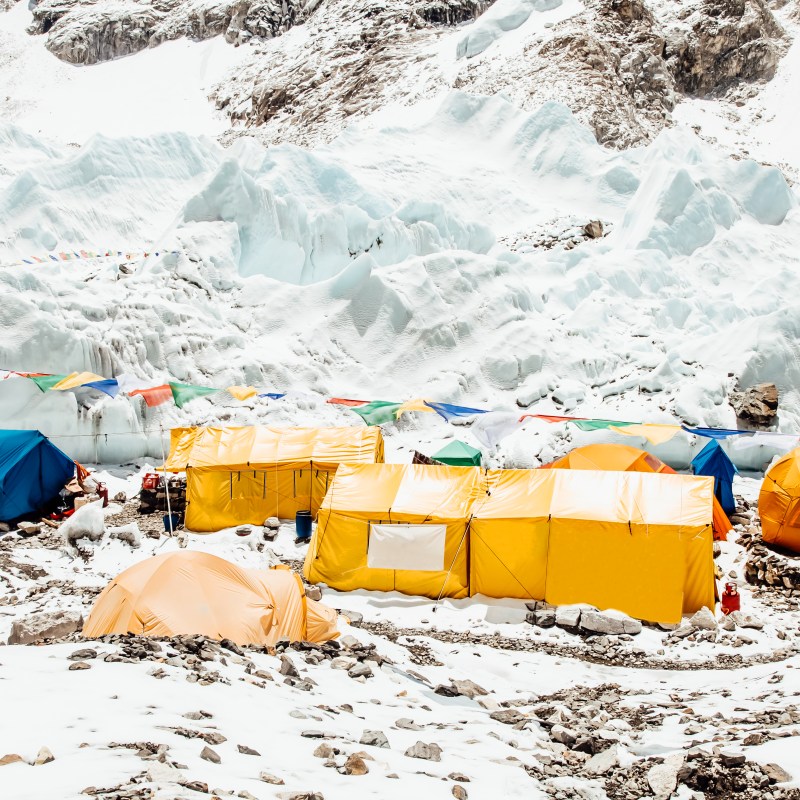
If you’ve heard anything about summitting Mt. Everest in Nepal, you’ve probably heard the word ‘Sherpa’ in the conversation.
Videos by TravelAwaits
The Sherpa people are an ethnic group native to Nepal, along with parts of India and Tibet. They share a lot of culture with Tibetan groups, having originated in the eastern Khams area of the region before migrating west.
Today, they’re renowned for guiding hopeful summiteers up Mt. Everest toward its peak.
And those mountaineers, no matter how experienced, wouldn’t be able to summit the world’s tallest peak without the help of Sherpas. Sherpas have traditional ecological knowledge that allows them to summit the mountains of their homelands, along with experience ascending and descending.
When you look at Mt. Everest climbing records, Nepalese Sherpas hold the records for the most frequent summits. Kami Rita achieved his 31st summit last May, followed by Pasang Dawa with 29 summits and Ngima Nuru with 24.
Let’s keep in mind, too, that Sherpas aren’t superheroes.
They’re hard workers, tough to the bone, and they know a thing or two about their home turf.
And they’re the absolute authorities on Mt. Everest—and I mean that in every sense, including literally, spiritually, culturally, and beyond.
So, why is one experienced Sherpa ringing the alarm bells over current Mt. Everest tourism?
Mingma Sherpa’s viral video shows that overtourism is taking hold
Sherpa Mingna D or Mingma Gyabu Sherpa is one of the most experienced Sherpas in the world. He’s summited Everest seven times, and has plenty of mountaineering experience beyond Mt. Everest. You might recognize him from 14 Peaks: Nothing Is Impossible.
On July 15, he shared a video that has since gone viral. The video shows a long and narrow cue that snakes up the side of Mt. Everest toward the summit, showing dozens of climbers in colorful gear.
It looks more like a line at an amusement park than at the world’s tallest mountaintop.
The caption reads, “Traffic at Mt. Everest – 8848.86m. The 2025 season on Mt. Everest has been one of the busiest yet—filled with record-breaking attempts and constant activity that, in truth, only serves short-term pride while putting immense pressure on our sacred mountain. It’s time we reflect. We must pause and reconsider how we approach Everest, not just for ourselves but for the mountain’s future.
Everest has given us countless opportunities—not only to the people of Nepal, but it has also played a vital role in supporting our national economy. Today, through this post, I humbly request all expedition companies, climbers, and leaders in the mountaineering community to raise their voices against this unchecked competition, the effects of global warming, and the often-overlooked hardships of the Sherpa people.
This is Mingma Sherpa, speaking out for our mountains, our people, and the generations to come. Let’s stop, think, and act before it’s too late.”
Sherpa Mingma’s message: stop and reconsider
If you feel like the overtourism machine is now running in overdrive, you aren’t alone. Across the world, cities and authorities managing popular landmarks are grappling with the realization that swift action is needed.
And it looks like there are a few possibilities for changing the current summitting operations for Mt. Everest:
- Create a lottery system or a daily cap on the number of summiteers allowed to climb, similar to hiking trails in Canada or Machu Picchu in Peru. This idea is a little complicated because weather conditions (which change daily) affect how groups are able to summit.
- Prevent all mountaineers from climbing. Bhutan, for example, has declared its mountains sacred and prevents any tourism ventures from disturbing its spiritual locations. Given Nepal’s dependence on Mt. Everest-related tourism, it might be too risky to eliminate tourism altogether.
- More training and education for authorities, tourists, and Sherpas. Mingma Sherpa mentions in his other videos that the qualified Sherpa population is declining. With a bit of financial and organizational support, climbing habits can be shaped and improved, along with the resources aimed at local Sherpa guides.
